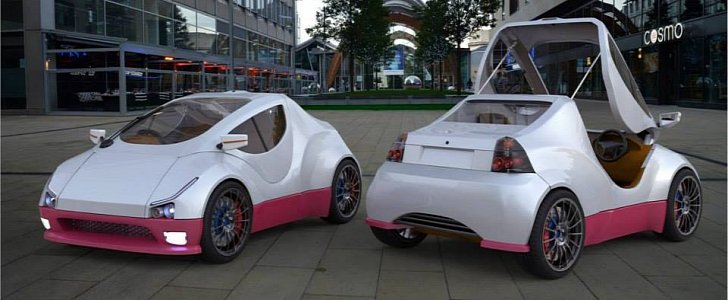Ever since the DeLorean DMC-12 happened, little did the automotive industry hear of vehicles being manufactured in these northern parts. However, the mysterious world of modern machinery has its way, and we could find ourselves being overwhelmed by yet another newborn that takes the shape of an electric vehicle.
Meet eroadster, Alex eroadster; it's a new 2-seater electric car currently in the preps in Co. Louth, Ireland. It may not be a Tesla Model S competitor, but it could just make for proper e-machine. The design is the brainchild of Tom Finnegan’s, an Irish inventor who is currently working with a company called Swift Composite Prototypes. They recently announced plans to develop and build a sporty EV with a bad name. OK, maybe we're mean, but they could have found something catchy-er.
What’s so special about this thing, anyway? According to the company manufacturing it as we speak, it will have very little evidence of traditional car build materials opting instead for new and radical materials, thus achieving massive weight reduction. Here’s a bit of the car’s official description:
“The car will be made of ultra- lightweight advanced composite materials including Carbon Fiber (used extensively in F1 technology) and Kevlar (used in bullet proof vests/glass). It will weigh in more than 30% lighter than most similar sized cars while being both stronger and safer at the same time.”
In terms of specs, we’re looking at the 250+ km (155+ miles) range, a 0 to 100 km/h (62 mph) reach in under 10 seconds and fast charging capabilities. How will they make it better than regular companies? Through a powerful AC motor with regenerative braking coupled with the latest advanced nanotechnology batteries, apparently.
Underneath the lifting roof will be an array of lightweight solar photovoltaic cells, which will provide a small amount of extra power to the car as well as helping to pump back some charge into the batteries when the car is not in use.
Add a futuristic look, lifting roof and doors, a tablet that can be removed from the dashboard and that allows the driver to communicate with the car and you get the big picture.
When will we see it on the road? Sometime next year, but there’s still no word on prices and other marketing details. Time will tell.
Meet eroadster, Alex eroadster; it's a new 2-seater electric car currently in the preps in Co. Louth, Ireland. It may not be a Tesla Model S competitor, but it could just make for proper e-machine. The design is the brainchild of Tom Finnegan’s, an Irish inventor who is currently working with a company called Swift Composite Prototypes. They recently announced plans to develop and build a sporty EV with a bad name. OK, maybe we're mean, but they could have found something catchy-er.
What’s so special about this thing, anyway? According to the company manufacturing it as we speak, it will have very little evidence of traditional car build materials opting instead for new and radical materials, thus achieving massive weight reduction. Here’s a bit of the car’s official description:
“The car will be made of ultra- lightweight advanced composite materials including Carbon Fiber (used extensively in F1 technology) and Kevlar (used in bullet proof vests/glass). It will weigh in more than 30% lighter than most similar sized cars while being both stronger and safer at the same time.”
In terms of specs, we’re looking at the 250+ km (155+ miles) range, a 0 to 100 km/h (62 mph) reach in under 10 seconds and fast charging capabilities. How will they make it better than regular companies? Through a powerful AC motor with regenerative braking coupled with the latest advanced nanotechnology batteries, apparently.
Underneath the lifting roof will be an array of lightweight solar photovoltaic cells, which will provide a small amount of extra power to the car as well as helping to pump back some charge into the batteries when the car is not in use.
Add a futuristic look, lifting roof and doors, a tablet that can be removed from the dashboard and that allows the driver to communicate with the car and you get the big picture.
When will we see it on the road? Sometime next year, but there’s still no word on prices and other marketing details. Time will tell.






